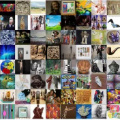For any type of microscopy image, getting a deep learning model to work well requires considerable effort to select a suitable architecture and time to train it. As there is a wide range of microscopes and experimental setups, designing a single model that can apply to multiple imaging domains, instead of having multiple per-domain models, becomes more essential. This task is challenging and somehow overlooked in the literature. In this paper, we present a multi-domain learning architecture for the classification of microscopy images that differ significantly in types and contents. Unlike previous methods that are computationally intensive, we have developed a compact model, called Mobincep, by combining the simple but effective techniques of depth-wise separable convolution and the inception module. We also introduce a new optimization technique to regulate the latent feature space during training to improve the network's performance. We evaluated our model on three different public datasets and compared its performance in single-domain and multiple-domain learning modes. The proposed classifier surpasses state-of-the-art results and is robust for limited labeled data. Moreover, it helps to eliminate the burden of designing a new network when switching to new experiments.
翻译:对于任何类型的显微镜图像,得到一个很好的深度学习模型需要相当大的工作量来选择合适的架构和训练时间。由于存在广泛的显微镜和实验设置,在设计一个单一模型可适用于多个成像领域,而不是每个领域都拥有多个模型的情况下变得更加必要。这项任务具有挑战性,而且在文献中被忽视了。在本文中,我们提出了一种多领域学习架构,用于区分类型和内容显著不同的显微镜图像的分类。与之前的方法不同的是,我们通过结合分离度的深度卷积和Inception模块的简单但有效的技术,开发了一种称为Mobincep的小型模型。我们还引入了一种新的优化技术,以在训练过程中调节潜在的特征空间,以提高网络性能。我们在三个不同的公共数据集上评估了我们的模型,并比较了其在单领域和多领域学习模式下的性能。所提出的分类器超过了最先进的结果,对有限标记数据具有鲁棒性,并且有助于消除切换到新实验时设计新网络的负担。

